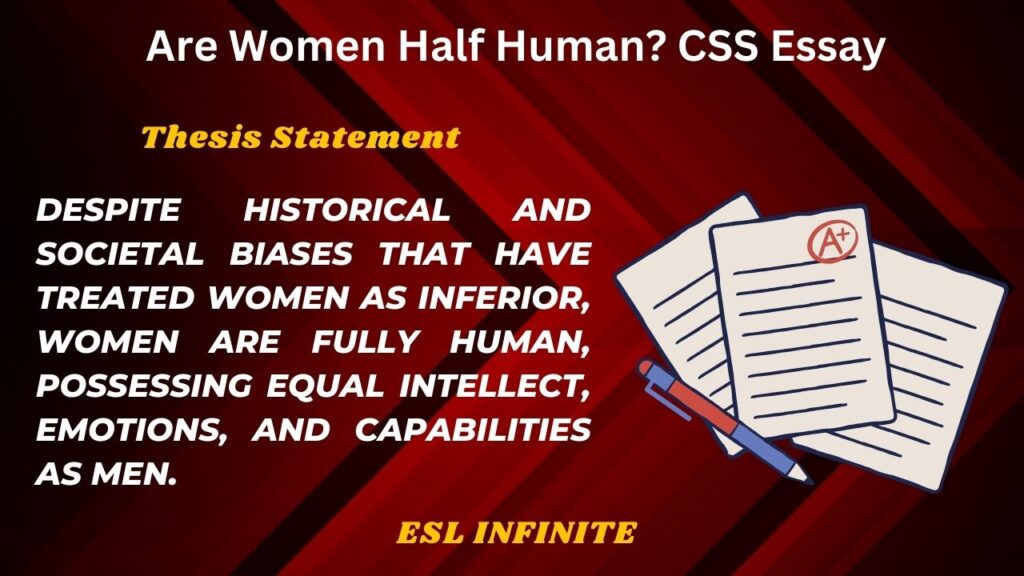Essay writing has always been a crucial and complex skill for the students. Particularly, the aspirants of competitive exams such as CSS and PMS struggle with writing 2000-plus-word essays. This post shares a detailed essay on the theme of Gender titled ‘Are Women Half Human?’.
CSS Essay: Are Women Half Human
Outline:
-
Introduction
A. Background on gender inequality and historical perceptions of women
B. The significance of the question “Are women half human?”
C. Thesis statement:
Despite historical and societal biases that have treated women as inferior, women are fully human, possessing equal intellect, emotions, and capabilities as men.
2. Historical Perspective on Women’s Humanity
A. Ancient and medieval views on women’s status
B. Religious and philosophical perspectives on women
C. Legal status of women in different societies
3. Women’s Rights and the Fight for Equality
A. The suffrage movement and women’s political rights
B. The feminist movement and its impact
C. Women’s rights in modern legal systems
- Biological and Psychological Equality of Women
A. Scientific evidence of cognitive and emotional capabilities
B. Differences versus inequalities: Understanding gender roles
C. The impact of education and opportunity on women’s achievements
- Cultural and Societal Biases Against Women
A. Gender stereotypes and their impact on perceptions of women
B. Discrimination in the workplace, politics, and leadership
C. Media representation and the objectification of women
- The Contribution of Women to Society
A. Women in science, politics, and leadership
B. Women’s role in families and communities
C. The importance of gender equality for societal progress
4. Conclusion
A. Restating the thesis: Women are fully human, deserving equal rights and recognition
B. The necessity of continued efforts for gender equality
C. The role of society in ensuring equal treatment for all
CSS Essay: Are Women Half Human
Introduction
Throughout history, women have often been marginalized, oppressed, and denied fundamental rights, leading to the provocative question: “Are women half-human?” Although it may seem absurd to question the full humanity of women, historical attitudes, societal norms, and institutionalized discrimination have often treated women as secondary to men. From ancient legal systems that denied women autonomy to modern-day gender biases that persist, the perception of women as “less than” has had profound consequences. This essay argues that despite historical and societal biases that have treated women as inferior, women are fully human, possessing equal intellect, emotions, and capabilities as men. Recognizing and addressing these biases is crucial for achieving true gender equality.
Historical Perspective on Women’s Humanity
The perception of women as “less than fully human” has deep roots in history. In ancient Greece, Aristotle described women as “imperfect men,” lacking full rational capacity. Similarly, in many medieval societies, women were legally considered the property of their fathers or husbands. Religious interpretations have also played a role in shaping gender roles, with many traditions historically viewing women as subservient. Laws in various societies restricted women’s rights to own property, vote, or receive education, reinforcing their inferior status. However, even in these restrictive societies, women contributed significantly to culture, governance, and intellectual life, proving their capabilities despite systemic oppression.
Women’s Rights and the Fight for Equality
The struggle for women’s rights has been a long and ongoing battle. The suffrage movement of the late 19th and early 20th centuries was a turning point, granting women the right to vote in many countries. Feminist movements in the 20th and 21st centuries have fought for equal pay, reproductive rights, and protection against gender-based violence. Legal advancements, such as anti-discrimination laws and gender quotas in politics, have aimed to rectify historical injustices. Despite these achievements, gender inequality persists, demonstrating that the fight for full recognition of women’s humanity is far from over.
Biological and Psychological Equality of Women
Science has debunked many myths regarding women’s supposed inferiority. Studies show that women are equally capable of intellectual and creative achievements as men. Differences in brain structure do not equate to cognitive superiority or inferiority but rather reflect diverse ways of processing information. Emotional intelligence, often regarded as a strength in leadership, is found to be equally distributed among men and women. Moreover, historical restrictions on women’s education and career opportunities have played a significant role in limiting their achievements, rather than any inherent incapacity.
Cultural and Societal Biases Against Women
Despite legal progress, cultural biases continue to undermine women’s full humanity. Gender stereotypes portray women as overly emotional, weak, or suited only for domestic roles. These biases are reflected in the workplace, where women face pay gaps, fewer leadership opportunities, and workplace harassment. In politics, women remain underrepresented, often facing greater scrutiny than their male counterparts. Media representation also plays a role in shaping public perceptions, frequently objectifying women or reinforcing traditional gender roles.
The Contribution of Women to Society
Women have made remarkable contributions to society, despite systemic barriers. In science, pioneers like Marie Curie and Rosalind Franklin have revolutionized our understanding of the world. Women leaders, from Cleopatra to modern figures like Angela Merkel, have demonstrated exceptional leadership abilities. Beyond formal achievements, women play essential roles in families and communities, contributing to education, caregiving, and economic stability. Societies that embrace gender equality benefit from diverse perspectives, increased economic growth, and improved social harmony.
Conclusion
The question “Are women half human?” is a stark reminder of the long history of gender discrimination. However, history, science, and contemporary achievements all affirm that women are fully human, and deserving of the same rights, respect, and opportunities as men. While progress has been made, persistent biases and structural inequalities must still be addressed. Achieving gender equality requires continuous effort from individuals, institutions, and governments. Recognizing women’s full humanity is not just a matter of justice—it is essential for the advancement of society as a whole.
This post gave a detailed CSS Essay: Are Women Half Human? Explore further resources:
Also Read:
Democracy in Pakistan Essay: Hopes and Hurdles
The CPEC is Expected to Transform Positively the Whole Socio-economic Condition of Pakistan
For Video Lectures: English Grammar Hub

